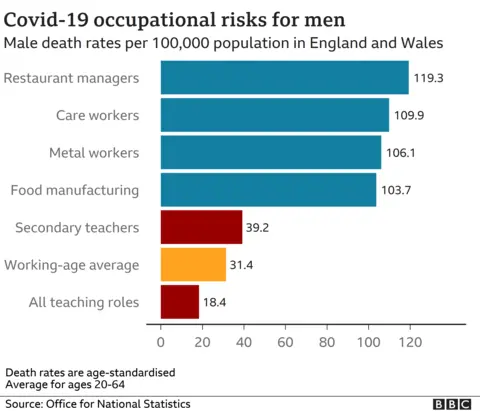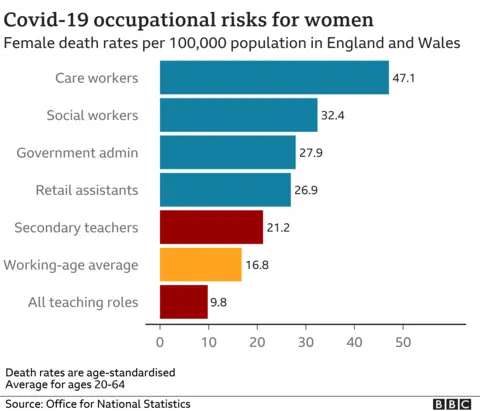Covid: Are teachers more at risk of dying?
 Getty Images
Getty ImagesTeachers are more at risk of infection and death from coronavirus, Labour Deputy Leader Angela Rayner has suggested, as she called for them to be vaccinated during February half term. But is that the case?
Speaking on the Today programme on Thursday, she said: "All front key line workers including teachers - the ONS [Office for National Statistics] data shows that they are more at risk of infection and death. That's a fact."
But the night before, England's Deputy Chief Medical Officer, Jonathan Van Tam told a coronavirus briefing: "Is there a clear signal in the data of a markedly increased rate of infection or mortality in teachers? No."
Labour has called on the government to "use the window" of the February half-term to vaccinate all teachers and support staff, ahead of potential plans to re-open schools in England from 8 March.
But what does the data show?
Teachers in England and Wales were not at significantly higher risk of death from coronavirus than the working age population, ONS figures covering March-December 2020 suggest.
But there was one group where the risk was higher. Male secondary school teachers saw about two-and-a-half times as many deaths as men of the same age from an equivalent professional background - just under 40 deaths per 100,000 people. But the difference was much less pronounced when comparing teachers with all working-age men.

What about other professions?
Looking at other occupations, female nurses were 50% more likely to die than the general female working-age population, and male nurses were more than twice as likely to die as other working-age men. Social care workers were also much more likely to die from coronavirus.
Frontline and social care workers are in priority group two for the vaccine, while teachers are not currently being prioritised as a profession.
There are other key worker groups - such as bus and taxi drivers - who had a higher average death rate than teachers and have also not been prioritised for the vaccine.
Jobs involving regular exposure to coronavirus and working in close proximity to others have higher coronavirus death rates, Ben Humberstone, head of Health Analysis and Life Events at the ONS says.
But although these death rate figures are adjusted for age, they don't take into account other key factors such as ethnicity.
"There are a complex combination of factors that influence the risk of death; from your age and your ethnicity, where you live and who you live with, to pre-existing health conditions," he says.
Labour is calling for "key workers in critical professions" to be added to the first phase of the vaccination programme.

What about infections?
Rates of infection across different jobs are less understood.
One thing we have is estimates of occupations with the highest potential exposure to coronavirus, conducted by the ONS back in May.
Medical roles including dentistry and nursing have among the highest exposure to disease, it suggests, although it does not take into account that these groups are likely to be wearing PPE.
School workers had moderate exposure to disease, with primary and nursery teachers more exposed than secondary.
As school buildings have often been closed to most pupils since March, many teachers may not have had as much regular exposure to children and other staff as they will do when schools fully reopen this year.
Supporters of moving teachers up the list say it will also allow schools to reopen safely and smoothly, with less staff sickness and potentially lower rates of transmission.


